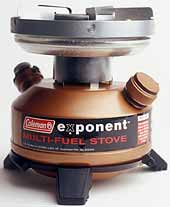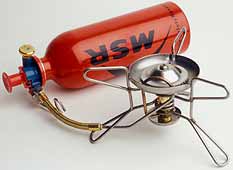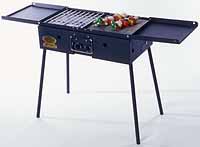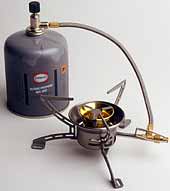![]() March - April 2003
March - April 2003
Outdoor Smarts
Camp Stoves
By Karen Berger
Photographs By John R. Fulton Jr.
What are you looking for in a cookstove? Blowtorch heat, delicate simmering, or a variety of fuel options? Check out these models for backpacking chefs or campground gourmets.
Need proof that a good camp stove is important? Just imagine one miserable, wet night when your cooker calls it quits, leaving you with a half-boiled pot of macaroni and cheese.
Stoves vary widely in fuel consumption, heat output, convenience, weight, simmer control, and cold-weather performance. So how do you choose one that will keep you—and your group—well fed?
First, it helps to know your needs. Boiling a pot of water in the Himalayas requires blowtorch heat; simmering a gourmet meal in a car campground demands more delicate control. Once you've decided on your requirements, you're ready to go shopping.
Liquid-fuel stoves
 Coleman's Exponent Multi-Fuel (BSA No. A01874) offers precise flame control. |
Basic liquid-fuel stoves burn white gas such as Coleman fuel, which is widely available at hardware stores and outdoor retailers. Many of today's liquid-fuel stoves also burn other fuels, including unleaded gasoline, kerosene, diesel, white spirits, or even jet fuel and petroleum-based dry-cleaning fluid. These multifuel stoves are especially useful in other countries, where white gas may not be readily available.
Liquid-fuel stoves are used by mountaineers because they produce the most heat in subfreezing temperatures. Two long-standing favorites are MSR's WhisperLite Internationale and its noisy big brother, the XKG Expedition.
Be warned, however: These stoves need regular maintenance and cleaning or they get fussy. In the last 10 years, MSR has solved one big maintenance problem with its "shaker jet" technology, which cleans the jet with a mere shake of the stove.
 MSR's WhisperLite utilizes "shaker jet" technology for easy cleaning. |
MSR has addressed another complaint, lack of flame control, with its DragonFly model, which combines blowtorch reliability with subtle flame control.
Coleman stoves are the locomotives of the camp-cooking world. Simple, reliable, and solid, they keep on chugging. The Exponent Multi-Fuel is one to check out.
At first glance, you might balk at the Multi-Fuel's hefty 22-ounce weight, but that includes both the stove and a fuel container sufficient for a weekend trip. If you're going out for longer, you'll need to bring an extra bottle of fuel.
Most manufacturers recommend that you use their bottles for optimum efficiency. Also, not all bottles fit all stoves, so if you opt for a less expensive fuel bottle, be sure it is compatible with your stove.
Canister stoves
 The Twister 270 HPZ has matchless lighting and can boil water in 3 1/2 minutes. |
Canister stoves burn pressurized gas, usually a blend of propane and butane. (The blend works better at colder temperatures than pure butane).
In addition to being quick, easy to operate, and reliable, canister stoves tend to be cheaper, smaller, and lighter than liquid-fuel stoves. They usually fit inside a cook-pot for convenient packing.
Campingaz, a French company, makes a wide selection, including the 10-ounce Twister 270 HPZ. It is an inexpensive model with wide, stable pot supports. The Bleuet Micro (about 4 ounces) is the company's lightweight offering. Both are distributed in the United States by Coleman.
Some caveats:
- Canister stoves function less efficiently at lower temperatures, especially below freezing, so it helps to preheat the fuel canister in a warm pocket.
- Like liquid-fuel bottles, not all canisters fit all stoves. Also, empty canisters are neither refillable nor recyclable and must be packed out.
- Finally, it takes practice to gauge how much fuel remains in the canister.
Other options
 For group camping, Rocky Mountain Range's Yellowstone model offers twin 30,000 BTU propane burners inside dual 14-by-14-inch cooking basins. |
Alternate fuels are also an option. Alcohol stoves have won new converts among backpackers. As easy to operate as lighting a match, these virtually maintenance-free stoves burn environmentally clean, widely available denatured alcohol.
Disadvantages? Alcohol doesn't burn as hot as other fuels, which means that the typical boil time is more than twice as long as for traditional stoves. Alcohol stoves are best for simple meals like instant noodles or freeze-dried foods.
 The OmniFuel stove, manufactured by Primus, burns virtually any type of fuel, liquid or canister. |
Finally, consider group stoves. A huge cauldron of pasta on a tiny canister stove is bad news, no matter how stable the supports. When car-camping or base-camping, where weight is not an issue, a large multiburner stove is a godsend for groups.
Coleman is the granddaddy of car-camping stoves. Its two-burner, dual-fuel stove is the tried-and-true veteran of a thousand campgrounds.
The gold-standard of the group cooking spectrum belongs to the Rocky Mountain Range Company. Its steel Yellowstone cookstove can do everything from grilling your fresh-caught fish to sautéing vegetables in a wok. At 40 pounds, this is a stove for serious gourmets.
Bon appétit!
Karen Berger is the author of nine books on outdoor adventure, including More Everyday Wisdom (Mountaineers Books, 2002). Visit her at www.hikerwriter.com.
Stove SafetyBSA regulations require that an adult supervise all stove-related activities. More stove safety information is available at www.scouting.org/pubs/gss/gss07.html#b. Never light a stove inside a tent. Lack of ventilation can cause carbon monoxide poisoning. Tent fabrics—even if flame-retardant—can be destroyed or damaged by a flare-up. If you have to travel by plane to get to a trailhead, note that stove fuel is not allowed to be transported on planes. You'll have to get it when you arrive at your destination. You should also check with your carrier regarding transportation of the stoves themselves. |
March-April 2003 Table of Contents
Copyright © 2003 by the Boy Scouts of America. All rights thereunder reserved; anything appearing in Scouting magazine or on its Web site may not be reprinted either wholly or in part without written permission. Because of freedom given authors, opinions may not reflect official concurrence.
| The Boy Scouts of America | http://www.scouting.org |